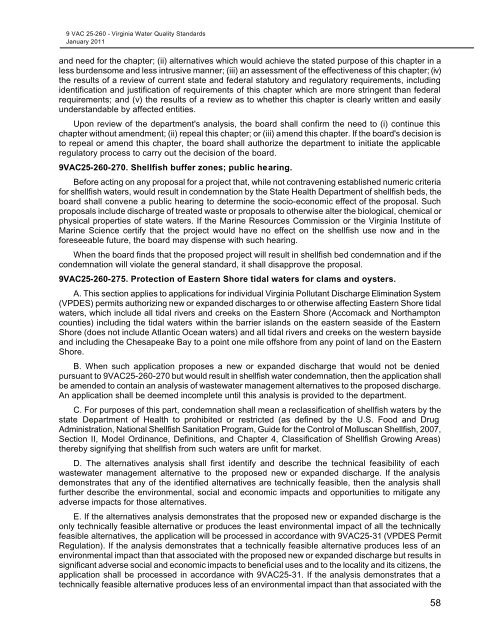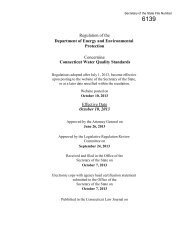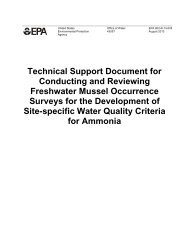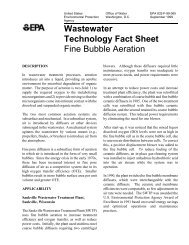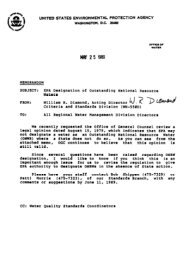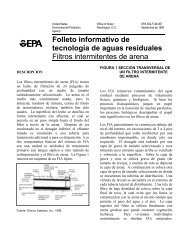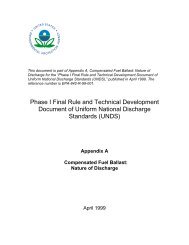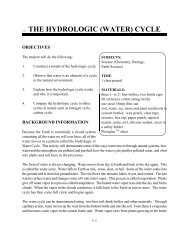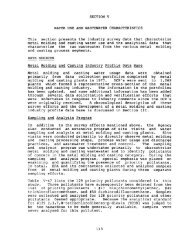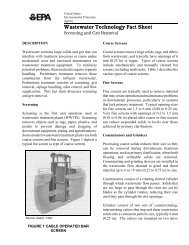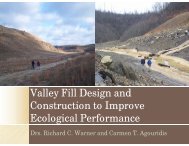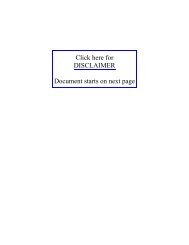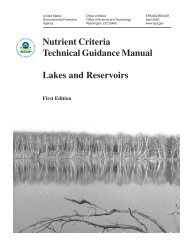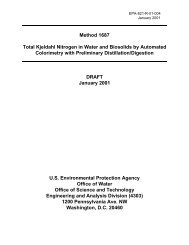Virginia Water Quality Standards - Water - US Environmental ...
Virginia Water Quality Standards - Water - US Environmental ...
Virginia Water Quality Standards - Water - US Environmental ...
You also want an ePaper? Increase the reach of your titles
YUMPU automatically turns print PDFs into web optimized ePapers that Google loves.
9 VAC 25-260 - <strong>Virginia</strong> <strong>Water</strong> <strong>Quality</strong> <strong>Standards</strong><br />
January 2011<br />
and need for the chapter; (ii) alternatives which would achieve the stated purpose of this chapter in a<br />
less burdensome and less intrusive manner; (iii) an assessment of the effectiveness of this chapter; (iv)<br />
the results of a review of current state and federal statutory and regulatory requirements, including<br />
identification and justification of requirements of this chapter which are more stringent than federal<br />
requirements; and (v) the results of a review as to whether this chapter is clearly written and easily<br />
understandable by affected entities.<br />
Upon review of the department's analysis, the board shall confirm the need to (i) continue this<br />
chapter without amendment; (ii) repeal this chapter; or (iii) amend this chapter. If the board's decision is<br />
to repeal or amend this chapter, the board shall authorize the department to initiate the applicable<br />
regulatory process to carry out the decision of the board.<br />
9VAC25-260-270. Shellfish buffer zones; public hearing.<br />
Before acting on any proposal for a project that, while not contravening established numeric criteria<br />
for shellfish waters, would result in condemnation by the State Health Department of shellfish beds, the<br />
board shall convene a public hearing to determine the socio-economic effect of the proposal. Such<br />
proposals include discharge of treated waste or proposals to otherwise alter the biological, chemical or<br />
physical properties of state waters. If the Marine Resources Commission or the <strong>Virginia</strong> Institute of<br />
Marine Science certify that the project would have no effect on the shellfish use now and in the<br />
foreseeable future, the board may dispense with such hearing.<br />
When the board finds that the proposed project will result in shellfish bed condemnation and if the<br />
condemnation will violate the general standard, it shall disapprove the proposal.<br />
9VAC25-260-275. Protection of Eastern Shore tidal waters for clams and oysters.<br />
A. This section applies to applications for individual <strong>Virginia</strong> Pollutant Discharge Elimination System<br />
(VPDES) permits authorizing new or expanded discharges to or otherwise affecting Eastern Shore tidal<br />
waters, which include all tidal rivers and creeks on the Eastern Shore (Accomack and Northampton<br />
counties) including the tidal waters within the barrier islands on the eastern seaside of the Eastern<br />
Shore (does not include Atlantic Ocean waters) and all tidal rivers and creeks on the western bayside<br />
and including the Chesapeake Bay to a point one mile offshore from any point of land on the Eastern<br />
Shore.<br />
B. When such application proposes a new or expanded discharge that would not be denied<br />
pursuant to 9VAC25-260-270 but would result in shellfish water condemnation, then the application shall<br />
be amended to contain an analysis of wastewater management alternatives to the proposed discharge.<br />
An application shall be deemed incomplete until this analysis is provided to the department.<br />
C. For purposes of this part, condemnation shall mean a reclassification of shellfish waters by the<br />
state Department of Health to prohibited or restricted (as defined by the U.S. Food and Drug<br />
Administration, National Shellfish Sanitation Program, Guide for the Control of Molluscan Shellfish, 2007,<br />
Section II, Model Ordinance, Definitions, and Chapter 4, Classification of Shellfish Growing Areas)<br />
thereby signifying that shellfish from such waters are unfit for market.<br />
D. The alternatives analysis shall first identify and describe the technical feasibility of each<br />
wastewater management alternative to the proposed new or expanded discharge. If the analysis<br />
demonstrates that any of the identified alternatives are technically feasible, then the analysis shall<br />
further describe the environmental, social and economic impacts and opportunities to mitigate any<br />
adverse impacts for those alternatives.<br />
E. If the alternatives analysis demonstrates that the proposed new or expanded discharge is the<br />
only technically feasible alternative or produces the least environmental impact of all the technically<br />
feasible alternatives, the application will be processed in accordance with 9VAC25-31 (VPDES Permit<br />
Regulation). If the analysis demonstrates that a technically feasible alternative produces less of an<br />
environmental impact than that associated with the proposed new or expanded discharge but results in<br />
significant adverse social and economic impacts to beneficial uses and to the locality and its citizens, the<br />
application shall be processed in accordance with 9VAC25-31. If the analysis demonstrates that a<br />
technically feasible alternative produces less of an environmental impact than that associated with the<br />
58


